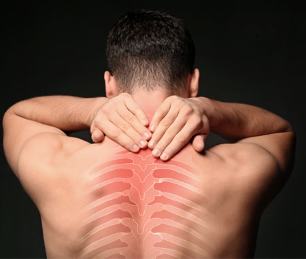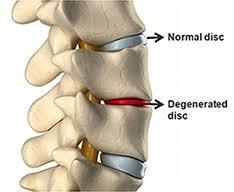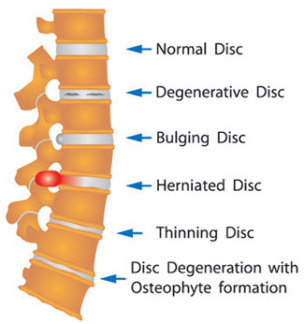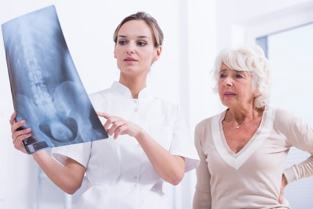
The disease of the low back pain is the most prevalent disease of all diseases of the spine. Such as osteochondrosis, directly represents a dystrophic-degenerative of the defeat of discs located between the vertebrae, then, as a consequence of this leads to changes in the structure, as well as the shape and the disks themselves.
With the increase of the age of man to these changes in her spine grow more and more, and at the age, about 40...de 45 years of low back pain of almost all the patients. In itself, the osteochondrosis of the thoracic spine develops a lot less often than, for example, of the lumbar spine and cervical spine so that the vertebrae are much less mobile than other vertebrates the parties. In addition, the back region in the area of the chest has also developed a brace for muscles, ralisant the support of the spine in the thoracic region, much better than the other.
What is this chest pain in the lower back?
Thoracic osteochondrosis directly is a bundle of the discs between the vertebrae, with a simultaneous decrease of their thickness, and therefore, followed by a pinched nerve endings located in the intercostal area of the chest of the man.
However, again, note that, as a physiological fixation of the ribs of the man is difficult enough, the department of the spine in the region of the chest the less prone to disease osteochondrosis.
Usually, in this process of pathology involving the discs between the vertebrae of the chest, composed of twelve thoracic vertebrae. But, most often, osteochondrosis thoracic pathological changes occur in Wernigerode the vertebrae. There are several degrees of the defeat of the osteochondrosis, and then, we will examine in more detail.
The predisposing factors for the development of the nursing of degenerative disc disease
The exact causes for the occurrence of degenerative disc disease, and thoracic of modern science at the end is not yet established. At this time, has decided to award in medicine, predisposing factors, or so-called - risk factors:
- a hereditary predisposition;
- an excessive physical activity;
- injuries of the spine, such as, for example, the fall or its harms.
- the changes that occur with age, intervertebral discs, and lead to a decrease of the hydration in the tissue of the disks;
- circulatory disorders in the chest.
The causes which favour the disease, osteochondrosis of the thoracic spine
In the basis of the degree of development of the disease osteochondrosis, in general, contributes to physical inactivity, it is the lack of muscular loads, which leads to the weakening of the muscular corset and, consequently, to an increase of the load on the intervertebral discs, and ligaments.
Other, additional reasons for the development of the nursing of degenerative disc disease are also:
- the cooling of the organism;
- of chronic stressful situations;
- transferred infection;
- poor working conditions;
- resulting of hormonal disorders in the body;
- the violation of the metabolic processes of the body;
- the presence of congenital abnormalities of the spine.
In the context of the impact of all of these factors, or sometimes even only one, in the discs between the vertebrae, over time, develop dystrophic-degenerative process irreversible:
- the nucleus pulposus is the disc begins to lose fluid, which stands out to ensure the smoothness of the function, that in the end, significantly reduces the combined of the function of this disk;
- immediately, a ring of fibrous-same vertebrae, due to an increase of the load, becomes increasingly vulnerable, which in turn leads to its progressive destruction.

The symptoms of breastfeeding degenerative disc disease and its symptoms
The clinical symptoms of the feeding of the degenerative disc disease is completely dependent on these factors:
- the age of the patient;
- the degree of the lesion of the disease;
- the stage of degenerative disc disease of the thoracic spine: a remission or a worsening.
The main signs of the degenerative disc disease in the chest are the following:
- a chest pain in the area of the spine, the so - called - Dorigo;
- lesion of the nerve endings in the spinal cord – neuralgia;
- abdominal chikungunya;
- heart syndrome, or modification of the cardiac muscle, with its sorrows, of the persistence of the same under the effect of nitroglycerin;
- pulmonary syndrome, in the form of flow in the lungs with signs of hypoxia, it is asphyxia.
The increase in body temperature in a patient with osteochondrosis is not observed, which is also in direct differential diagnosis symptom. Back pain in the region of the chest indicates the appearance of cracks in the fibrous ring and the deformation of the nucleus pulposus. When required to palpate, the pain region of the chest only mitigated.
In addition, the symptoms characteristic of the feeding of the degenerative disease of the disc when compression of myelopathy, it is the deformation of nerve endings, are the following:
- the feeling of "chills" - paresthesia;
- the pain during the of this nerve;
- to decrease the sensitivity to temperature and touch;
- the violation of the vertebral column motor function.

The degree of the disease osteochondrosis
The different degrees of the disease osteochondrosis are characterized by each of its pathology, of each have only their clinical signs. Modern medicine is off four degrees of degenerative disc disease, and thoracic and, respectively, four periods of its development. We will examine in more detail.
The first degree, for which the characteristic is that the inside of the fibrotic ring cracks, which subsequently enters the nucleus pulposus is. This period of development of the disease osteochondrosis is characterized by the following features:
- the onset of pain in the spine in the place of his defeat, but not beyond the limits of the location of the onset of the disease;
- these pains can be worn as a permanent character, in order to be in the form of lumbago;
- may produce spasmodic contraction of the muscle, accompanied by pain in the region of the heart.
In the second degree, as the development period of breastfeeding of the degenerative disc disease, is characterized by the appearance increased intervertbral of the mobility with the clinical manifestations:
- appear the subluxations of the thoracic spine;
- the pains increase during motion;
- you get discomfort in the long-term persistence of the posture.
The third degree, characterized by a period is interrupted when the fibrous ring and beyond between the nucleus pulposus is. In this period of the disease, osteochondrosis of the thoracic spine begin to appear hernias, the clinical signs are quite heavy. That is, neuro-vascular, muscular-tonic and reflex-dystrophic.
Outside of these hours, the third degree of the disc degeneration thoracic is a characteristic of a change in one of the following states of the vertebral column:
- the weakness of the attachment of the provisions of the vertebral column;
- the limitations of the mobility of the vertebral division, which manifests itself in the form of kyphosis or scoliosis.
The fourth degree, related to the same time period, in which dystrophic-the degenerative process affects all the structures are surrounded by the spinal column. In this pathological involved yellow, interspinal, and other ligaments, and structures surrounding the vertebral column, arises fibrosis. In this period of the disease of the low back pain, clinically, it is observed, that is called the state of forgiveness.
The possible complications during osteochondrosis
At the continuation of the progression of the disease breast osteochondrosis, possibly the development of complications category, such as:
- the inflammation of the nerve endings in the spinal cord;
- the onset of disc herniations;
- the development of dystonia;
- the development of the herniation Schmorl's;
- the disease spondylosis;
- the increase in pathological bony growths - osteophytes;
- significant reduction of the spinal canal.
It should be noted that the degree of severity of complications of osteochondrosis depends entirely on the pace of progress of the process of onset of the disease and, of course, the effectiveness of treatment methods of degenerative disc disease of the thoracic spine.

The diagnosis of breast degenerative disc disease and its methods
In practice, we apply several methods for the diagnosis of breast-feeding to a degenerative disc disease. Among them, the most common is the x-ray, the results are quite informative. The signs of the nursing of degenerative disc disease, identified in this study are:
- violated the contours of the discs between the vertebrae;
- the edges of plates purchased hilly nature;
- the intervertebral discs have changed shape;
- resulting from osteophytes – bony pathological expansion;
- increased and are hanging on the shoots of the vertebrae;
- the body of the thoracic vertebrae have changed their normal shape;
- significantly reduces the size of the height of the discs between the vertebrae;
- formed by a herniation of the discs between the vertebrae.
In some cases, practiced the diagnostic method of the breast-feeding of degenerative disc disease by radio-opaque of the research, defines the signs of this disease:
- in the case of a running condition of the contrast agent fills the disk between the vertebrae completely;
- with the help of a contrast agent can see the outline of the nucleus pulposus, involving the nature bumpy;
- during the destruction of an intervertebral disc to a large extent, the contrast of the substance penetrates to the beyond, until the penetration into the vertebral canal.
The treatment of breast degenerative disc disease
The treatment of breast degenerative disc disease can be one of the following ways, applied taking into account the results of the diagnosis, the nursing of degenerative disc disease, namely:
- conservative-traditional treatment;
- the treatment of the feeding of the degenerative disease of the disc with the help of the traction;
- quickly, surgery.
Nothing new, of course, here, is not yet invented, and as such the treatment of the feeding of the degenerative disease of the disk, called conservative, is already the traditional for the treatment of any type of degenerative disease of the disc. In all cases, always conservative-medicated method of treatment of breast degenerative disc disease by the designation of a non-steroidal anti-inflammatory drugs, aimed at the relief of the pain. It should be noted that these drugs are very well eliminate the inflammatory processes, as well as resolve the pockets, helping to reduce the process of compression of the nerve root. In the most complex cases of disease of the low back pain, the doctor may prescribe in addition to another a number of drugs, for example, a kind of powerful painkillers, muscle relaxants, which block the onset of muscle spasms.
When the pain retreats or she was able to stop, it is during the remission, is named rogue, the treatment of the therapy, and, in addition, PHYSIOTHERAPY and massage. The primary means of control, and the prevention of this disease in the treatment of physical therapy is the magnet therapy by therapeutic devices.
In addition to the items mentioned above, for the treatment of breast disease degenerative disk can be used with success and traction to a medical treatment, a treatment breast of degenerative disc disease by means of a stretch. With this method, paraspinal muscles, tissues and ligaments are exposed to stretching, which leads to an increase in the intervertebral distance. Even half a millimetre would be enough to reduce the swelling, the elimination of compression, as well as the removal of tension in the muscles of the spine.
And here surgical intervention is recommended when the above methods of treatment of breast degenerative disc disease do not give the expected result.





























